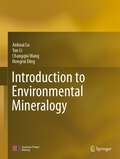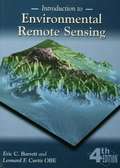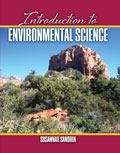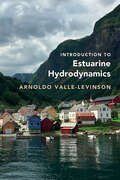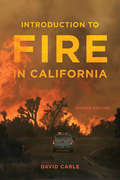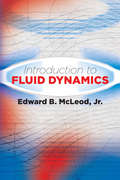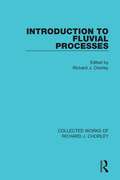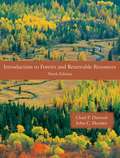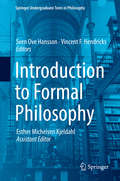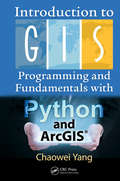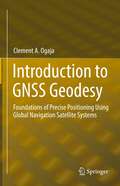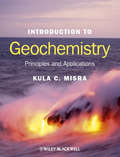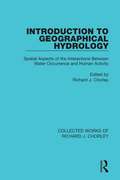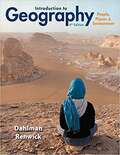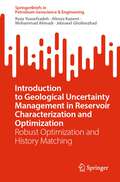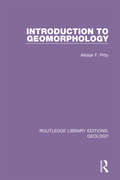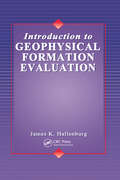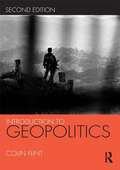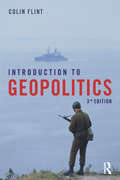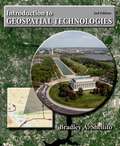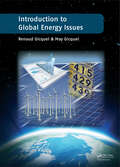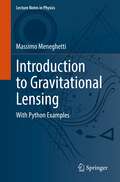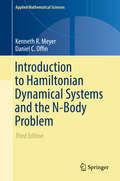- Table View
- List View
Introduction to Environmental Mineralogy
by Yan Li Anhuai Lu Changqiu Wang Hongrui DingThis book focuses on the environmental property of minerals including mineralogical record of environmental changes, mineralogical influence on the environmental quality, mineralogical evaluation of the environment, mineralogical processing of environmental pollutants and interaction between minerals and microbes. Understanding of the environmental property of minerals is a good supplement to the traditional concept of “mineral”. By demonstrating plenty of case studies with easy-to-understand figures and tables, this book introduces the environmental effects of interaction between minerals and microbes, physiological and ecological effects of biomineralization, reductive precipitation property of iron sulfide minerals, photocatalytic reduction property of sphalerite, photocatalytic oxidation property of rutile, tubular structure property of chrysotile, tunnel structure property of K-feldspar tetrahedron, tunnel structure property of cryptomelane octahedron, nano property of cryptomelane, crystallization property of jarosite, interaction between semiconducting minerals and microbes, pathological mineralization of human body, mineralogical processing of inorganic pollutants, mineralogical degradation of organic pollutants, mineralogical purification of smoke-type pollutants, mineralogical evaluation of soil environmental quality, mineralogical prevention and control of waste pollutants and mineralogical processing of mine tailings. The book is written for environmental mineralogist as well as postgraduates majoring in environmental science.
Introduction to Environmental Remote Sensing
by Eric C. Barrett Leonard F. CurtisTaking a detailed, non-mathematical approach to the principles on which remote sensing is based, this book progresses from the physical principles to the application of remote sensing.
Introduction to Environmental Science
by Susannah SandrinIntroduction To Environmental Science by Susannah Sandrin
Introduction to Estuarine Hydrodynamics
by Arnoldo Valle-LevinsonThis textbook provides an in-depth overview of the hydrodynamics of estuaries and semi-enclosed bodies of water. It begins by describing the typical classification of estuaries, followed by a presentation of the quantitative tools needed to study these basins: conservation of mass, salt, heat, momentum, and the thermodynamic equation of seawater. Further topics explore tides in homogeneous basins, including shallow water tides and tidal residual flows, wind-driven flows in homogeneous basins, density-driven flows, as well as interactions among tides, winds and density gradients. The book proposes a classification of semi-enclosed basins that is based on dominant dynamics, comparing forcing agents and restorative or balancing forces. Introduction to Estuarine Hydrodynamics provides an introduction for advanced students and researchers across a range of disciplines - Earth science, environmental science, biology, chemistry, geology, hydrology, physics - related to the study of estuarine systems.
Introduction to Fire in California: Second Edition (California Natural History Guides)
by David CarleThe essential guide to California's long relationship with fire, updated for the climate-change generation. What is fire? How are wildfires ignited? How do California's weather and topography influence fire? How did Indigenous people use fire on the land we now call California? David Carle's clearly written, dramatically illustrated first edition of Introduction to Fire in California helped Californians, including the millions who live near naturally flammable wildlands, better understand their own place in the state's landscape. In this revised edition, Carle covers the basics of fire ecology; looks at the effects of fire on people, wildlife, soil, water, and air; discusses fire-fighting organizations and land-management agencies; and explains how to prepare for an emergency and what to do when one occurs. This second edition brings the wildfire story up to the year 2020, with information about recent extreme and deadly fire events and the evidence that climate change is swiftly changing the wildfire story in California. This update reflects current debates about California's future as a climate-crisis leader facing massive, annual natural disasters; the future of California development and housing; and the critically necessary alternatives to traditional energy options. Features:A larger, more reader-friendly page formatMore than 110 color illustrations and mapsAn overview of major wildfires in California's historyAn updated and expanded discussion of the effect of climate change on fires in natural landscapesTips on what to do before, during, and after firesDiscussion of utility companies and massive power shutoffs
Introduction to Fluid Dynamics
by Edward B. Mcleod Jr.Concise, unified, and logical, this introduction to the study of the basic principles of fluid dynamics emphasizes the statement of problems in mathematical language. In addition to its value as a reference for professional engineers, this volume is suitable for advanced undergraduates and graduate students of mathematics and engineering. Some familiarity with the algebra of vector fields is assumed, and a useful appendix provides a succinct review of vector algebra.An introductory chapter covers fundamental notions from the continuum hypothesis to steady-state flow. Succeeding chapters explore conservation of mass, forces acting on a fluid in equilibrium, dynamic equations of motion, irrotational motion, integration of Euler's equation in special cases, and flows representable by harmonic functions. Additional topics include two dimensional flows, rectilinear vortices, general vortex motion, flows with a free boundary, and compressible fluids.
Introduction to Fluvial Processes (Collected Works of Richard J. Chorley)
by Richard J. ChorleyOriginally published in this form in 1971, the content of this book was originally part of a larger composite volume ‘Water, Earth and Man’ (1969) which provided a synthesis of hydrology, geomorphology and socio-economic geography. This volume brings together the systematic theme of geomorphology while maintaining a link with the original book which emphasised the benefit of the study of water being considered in the widest sense within the physical and social environments.
Introduction to Forests and Renewable Resources
by John C. Hendee Chad P. DawsonThe introductory course in natural resources is broader and more diverse than ever. Today's students need to know how to manage forest, wildlife, watershed, and range resources in a variety of environments and serving the needs of myriad stakeholders. To that end, Chad Dawson has built on the foundation established by him and the late John Hendee to bring Introduction to Forests and Renewable Resources thoroughly up to date. The Ninth Edition has been reorganized to better address content-for example, policy and the differences between managing federal, state, and private land--that applies to all resources. While forests continue to be emphasized, more coverage is provided to other resources and to achieving management goals for multiple resources when considering topics like fire and recreation.
Introduction to Formal Philosophy (Springer Undergraduate Texts In Philosophy Ser.)
by Vincent F. Hendricks Sven Ove Hansson Esther Michelsen KjeldahlThis Undergraduate Textbook introduces key methods and examines the major areas of philosophy in which formal methods play pivotal roles. Coverage begins with a thorough introduction to formalization and to the advantages and pitfalls of formal methods in philosophy. The ensuing chapters show how to use formal methods in a wide range of areas. Throughout, the contributors clarify the relationships and interdependencies between formal and informal notions and constructions. Their main focus is to show how formal treatments of philosophical problems may help us understand them better. Formal methods can be used to solve problems but also to express new philosophical problems that would never have seen the light of day without the expressive power of the formal apparatus. Formal philosophy merges work in different areas of philosophy as well as logic, mathematics, computer science, linguistics, physics, psychology, biology, economics, political theory, and sociology. This title offers an accessible introduction to this new interdisciplinary research area to a wide academic audience.
Introduction to GIS Programming and Fundamentals with Python and ArcGIS®
by Chaowei YangCombining GIS concepts and fundamental spatial thinking methodology with real programming examples, this book introduces popular Python-based tools and their application to solving real-world problems. It elucidates the programming constructs of Python with its high-level toolkits and demonstrates its integration with ArcGIS Theory. Filled with hands-on computer exercises in a logical learning workflow this book promotes increased interactivity between instructors and students while also benefiting professionals in the field with vital knowledge to sharpen their programming skills. Readers receive expert guidance on modules, package management, and handling shapefile formats needed to build their own mini-GIS. Comprehensive and engaging commentary, robust contents, accompanying datasets, and classroom-tested exercises are all housed here to permit users to become competitive in the GIS/IT job market and industry.
Introduction to GNSS Geodesy: Foundations of Precise Positioning Using Global Navigation Satellite Systems
by Clement A. OgajaIntroduction to GNSS Geodesy is a concise reference for beginners and experts in GNSS-based satellite geodesy. It covers all of the important concepts in almost a third of the space of the other GNSS books. Th e book begins with a case study in Augmented Reality to set the stage for what is to come and then moves on to the key elements of GNSS geodesy that make accurate and precise geopositioning possible. For example, it is important to understand the geodetic reference systems and the associated GNSS data processing strategies that enable both accurate and high-precision geopositioning. Chapter 2 gives an overview of GNSS constellations and signals, highlighting important characteristics. Chapter 3 then introduces reference systems in geodesy, covering such topics as time systems, geodetic datums, coordinate systems, coordinate conversions and transformations, and International Terrestrial Reference Frame. Th is lays the framework for the rest of the book. Chapters 4 and 5 dig deep into mathematical formulation of GNSS parameter estimation and observation models. All the concepts are presented clearly and concisely, with diagrams to assist reader comprehension. Chapter 6 describes Continuously Operating Reference Station (CORS) networks and their role in geodesy and definition of reference frames. Various global and regional CORS networks are presented in this section. Th e chapter also covers GNSS data and common formats such as RINEX and RTCM. Chapter 7 introduces the whole cycle of GNSS data processing, including preprocessing, ambiguity fixing, and solution reprocessing methods as commonly used in both epoch solutions and time series data. Th e book concludes with appendices on orbit modelling, GNSS linear combinations, application examples, and an example linear model.
Introduction to Geochemistry: Principles and Applications
by Kula C. MisraThis book is intended to serve as a text for an introductory course in geochemistry for undergraduate/graduate students with at least an elementary–level background in earth sciences, chemistry, and mathematics. The text, containing 83 tables and 181 figures, covers a wide variety of topics — ranging from atomic structure to chemical and isotopic equilibria to modern biogeochemical cycles — which are divided into four interrelated parts: Crystal Chemistry; Chemical Reactions (and biochemical reactions involving bacteria); Isotope Geochemistry (radiogenic and stable isotopes); and The Earth Supersystem, which includes discussions pertinent to the evolution of the solid Earth, the atmosphere, and the hydrosphere. In keeping with the modern trend in the field of geochemistry, the book emphasizes computational techniques by developing appropriate mathematical relations, solving a variety of problems to illustrate application of the mathematical relations, and leaving a set of questions at the end of each chapter to be solved by students. However, so as not to interrupt the flow of the text, involved chemical concepts and mathematical derivations are separated in the form of boxes. Supplementary materials are packaged into ten appendixes that include a standard–state (298.15 K, 1 bar) thermodynamic data table and a listing of answers to selected chapter–end questions. Additional resources for this book can be found at: www.wiley.com/go/misra/geochemistry.
Introduction to Geographical Hydrology: Spatial Aspects of the Interactions Between Water Occurrence and Human Activity (Collected Works of Richard J. Chorley #Vol. 408)
by Richard J. ChorleyOriginally published in this form in 1971, the content of this book was originally part of a larger composite volume ‘Water, Earth and Man’ (1969) which provided a synthesis of hydrology, geomorphology and socio-economic geography. This volume brings together the systematic theme of spatial aspects of the interactions between water occurrence and human activity.
Introduction to Geography: People, Places and Environment
by Carl Dahlman William RenwickIntroduction to Geography: People, Places, & Environment, Sixth Edition introduces the major tools, techniques, and methodological approaches of the discipline through new applied visual features that engage students and reinforce real-world connections. <P><P> The authors emphasize the integration of various aspects of geographic processes and systems by discussing what happens in one set of geographic processes and how that affects others. For example, what happens in economic systems affects environmental conditions; what happens to climate affects political dynamics. The Sixth Edition has been tightly integrated with MasteringGeography™, Pearson’s online homework, tutorial, and assessment product designed to improve results by helping students quickly master concepts.
Introduction to Geological Uncertainty Management in Reservoir Characterization and Optimization: Robust Optimization and History Matching (SpringerBriefs in Petroleum Geoscience & Engineering)
by Jebraeel Gholinezhad Reza Yousefzadeh Alireza Kazemi Mohammad AhmadiThis book explores methods for managing uncertainty in reservoir characterization and optimization. It covers the fundamentals, challenges, and solutions to tackle the challenges made by geological uncertainty. The first chapter discusses types and sources of uncertainty and the challenges in different phases of reservoir management, along with general methods to manage it. The second chapter focuses on geological uncertainty, explaining its impact on field development and methods to handle it using prior information, seismic and petrophysical data, and geological parametrization. The third chapter deals with reducing geological uncertainty through history matching and the various methods used, including closed-loop management, ensemble assimilation, and stochastic optimization. The fourth chapter presents dimensionality reduction methods to tackle high-dimensional geological realizations. The fifth chapter covers field development optimization using robust optimization, including solutions for its challenges such as high computational cost and risk attitudes. The final chapter introduces different types of proxy models in history matching and robust optimization, discussing their pros and cons, and applications. The book will be of interest to researchers and professors, geologists and professionals in oil and gas production and exploration.
Introduction to Geomorphology (Routledge Library Editions: Geology #21)
by Alistair F. PittyThe study of landforms is becoming increasingly scientific. This book, first published in 1971, attempts to do justice to the work done in the last few decades, but strives to avoid a too uncritical acceptance of contemporary trends. The author first examines the fundamental characteristics and basic postulates of geomorphology. He then seeks to define the systematic stages through which the study of the landforms of a given area might proceed. Examples are drawn from a wide geographical range with emphasis on presenting examples of actual observations and measurements. The final section presents concise descriptions of simple and inexpensive methods of acquiring field data in landform study.
Introduction to Geophysical Formation Evaluation
by James K. HallenburgThese three works cover the entire field of formation evaluation, from basic concepts and theories, through standard methods used by the petroleum industry, on to new and exciting applications in environmental science and engineering, hydrogeology, and other fields. Designed to be used individually or as a set, these volumes represent the first comprehensive assessment of all exploration methodologies. No other books offer the breadth of information and range of applications available in this set.The first volume, Introduction to Geophysical Formation Evaluation, is the perfect introductory reference for environmental professionals without previous training in the field. It explains the fundamentals of geophysical exploration and analysis, illuminates the underlying theories, and offers practical guidance on how to use the available methodologies. General information on material behavior, porosity, tortuosity, permeability, cores, resistivity, radioactivity, and more provides a solid foundation for more advanced studies.The second volume, Standard Methods of Geophysical Formation Evaluation builds on the basic precepts presented in the first work but can be used alone as a self-contained reference. It covers all the petroleum-oriented standard methods which, until recently, have comprised the majority of applications of geophysical formation evaluation. It also points out non-hydrocarbon uses of petroleum methods. This volume provides complete practical information and instructions on using the standard exploration and evaluation methods. It presents comprehensive, painstakingly detailed instructions for resistivity, radiation, and acoustic methods.The third volume, Non-Hydrocarbon Methods of Geophysical Formation Evaluation, discusses uses of formation evaluation in environmental science and engineering, hydrogeology, and other fields outside the petroleum industry, and demonstrates how the standard methods can be adapted to these non-hydrocarbon purpos
Introduction to Geopolitics
by Colin FlintThis clear and concise introductory textbook guides students through their first engagement with geopolitics. It offers a clear framework for understanding contemporary conflicts by showing how geography provides opportunities and limits upon the actions of countries, national groups, and terrorist organizations. This second edition is fundamentally restructured to emphasize geopolitical agency, and non-state actors. The text is fully revised, containing a brand new chapter on environmental geopolitics, which includes discussion of climate change and resource conflicts. The text contains updated case studies, such as the Korean conflict, Israel-Palestine and Chechnya and Kashmir, to emphasize the multi-faceted nature of conflict. These, along with guided exercises, help explain contemporary global power struggles, environmental geopolitics, the global military actions of the United States, the persistence of nationalist conflicts, the changing role of borders, and the new geopolitics of terrorism, and peace movements. Throughout, the readers are introduced to different theoretical perspectives, including feminist contributions, as both the practice and representation of geopolitics are discussed. Introduction to Geopolitics is an ideal introductory text which provides a deeper and critical understanding of current affairs, geopolitical structures and agents. The text is extensively illustrated with diagrams, maps, photographs and end of chapter further reading. Both students and general readers alike will find this book an essential stepping-stone to understanding contemporary conflicts.
Introduction to Geopolitics
by Colin FlintThis new updated edition of Introduction to Geopolitics presents the overarching themes of geopolitical structures and agents in an engaging and accessible manner, which requires no previous knowledge of theory or current affairs. Using new pertinent case studies and guided exercises the title explains the contemporary global power of the United States and the challenges it is facing, the persistence of nationalist conflicts, migration, cyberwar, terrorism, and environmental geopolitics. Case studies of the rise of the so-called Islamic State, the South China Sea disputes, the Syrian civil war, the Korean conflict, and Israel-Palestine emphasize the multi-faceted nature of conflict. The book raises questions by incorporating international and long term historical perspectives and introduces readers to different theoretical viewpoints, including feminist contributions. The new edition features expanded sections on network geopolitics and non-state actors, a new section on geopolitics of transnational business, cyberwar, an interpretation of ISIS within historical geopolitical trends, as well as expanded discussion of the relevance of Boserup and neo-Malthusians to environmental geopolitics. Introduction to Geopolitics will provide its readers with a set of critical analytical tools for understanding the actions of states as well as non-state actors acting in competition over resources and power. Both students and general readers will find this book an essential stepping-stone to a deeper and critical understanding of contemporary conflicts.
Introduction to Geospatial Technologies (Second Edition)
by Bradley A. ShellitoCombining both theoretical coverage and hands-on lab work, and accessible to majors and non-majors alike, Bradley Shellito's Introduction to Geospatial Technologies has become a new favorite for the digital Earth course. The new edition reflects the latest developments in the field, including how scientists are using GIS data with cloud technology. With lab activities that utilize both widely available freeware and ArcGIS, instructors can tailor the course to their students.
Introduction to Global Energy Issues
by Renaud Gicquel May GicquelFrom the discovery of fire to that of the atom, the development of human societies has largely been based on the conquest of energy. In all countries, energy has gradually become one of the key factors of social and economic development, as well as capital, labor and natural resources, and now no one can do without it. After decades of cheap energy
Introduction to Gravitational Lensing: With Python Examples (Lecture Notes in Physics #956)
by Massimo MeneghettiThis book introduces the phenomenology of gravitational lensing in an accessible manner and provides a thorough discussion of the related astrophysical applications. It is intended for advanced undergraduates and graduate students who want to start working in this rapidly evolving field. This includes also senior researchers who are interested in ongoing or future surveys and missions such as DES, Euclid, WFIRST, LSST. The reader is guided through many fascinating topics related to gravitational lensing like the structure of our galaxy, the searching for exoplanets, the investigation of dark matter in galaxies and galaxy clusters, and several aspects of cosmology, including dark energy and the cosmic microwave background. The author, who has gained valuable experience as academic teacher, guides the readers towards the comprehension of the theory of gravitational lensing and related observational techniques by using simple codes written in python. This approach, beyond facilitating the understanding of gravitational lensing, is preparatory for learning the python programming language which is gaining large popularity both in academia and in the private sector.
Introduction to Hamiltonian Dynamical Systems and the N-Body Problem
by Kenneth R. Meyer Daniel C. OffinThis third edition text provides expanded material on the restricted three body problem and celestial mechanics. With each chapter containing new content, readers are provided with new material on reduction, orbifolds, and the regularization of the Kepler problem, all of which are provided with applications. The previous editions grew out of graduate level courses in mathematics, engineering, and physics given at several different universities. The courses took students who had some background in differential equations and lead them through a systematic grounding in the theory of Hamiltonian mechanics from a dynamical systems point of view.This text provides a mathematical structure of celestial mechanics ideal for beginners, and will be useful to graduate students and researchers alike. Reviews of the second edition:"The primary subject here is the basic theory of Hamiltonian differential equations studied from the perspective of differential dynamical systems. The N-body problem is used as the primary example of a Hamiltonian system, a touchstone for the theory as the authors develop it. This book is intended to support a first course at the graduate level for mathematics and engineering students. … It is a well-organized and accessible introduction to the subject … . This is an attractive book … ." (William J. Satzer, The Mathematical Association of America, March, 2009) “The second edition of this text infuses new mathematical substance and relevance into an already modern classic … and is sure to excite future generations of readers. … This outstanding book can be used not only as an introductory course at the graduate level in mathematics, but also as course material for engineering graduate students. … it is an elegant and invaluable reference for mathematicians and scientists with an interest in classical and celestial mechanics, astrodynamics, physics, biology, and related fields.” (Marian Gidea, Mathematical Reviews, Issue 2010 d)
Introduction to Hamiltonian Fluid Dynamics and Stability Theory (Monographs And Surveys In Pure And Applied Mathematics Ser. #102)
by Gordon E SwatersHamiltonian fluid dynamics and stability theory work hand-in-hand in a variety of engineering, physics, and physical science fields. Until now, however, no single reference addressed and provided background in both of these closely linked subjects. Introduction to Hamiltonian Fluid Dynamics and Stability Theory does just that-offers a comprehensive introduction to Hamiltonian fluid dynamics and describes aspects of hydrodynamic stability theory within the context of the Hamiltonian formalism.The author uses the example of the nonlinear pendulum-giving a thorough linear and nonlinear stability analysis of its equilibrium solutions-to introduce many of the ideas associated with the mathematical argument required in infinite dimensional Hamiltonian theory needed for fluid mechanics. He examines Andrews' Theorem, derives and develops the Charney-Hasegawa-Mima (CMH) equation, presents an account of the Hamiltonian structure of the Korteweg-de Vries (KdV) equation, and discusses the stability theory associated with the KdV soliton.The book's tutorial approach and plentiful exercises combine with its thorough presentations of both subjects to make Introduction to Hamiltonian Fluid Dynamics and Stability Theory an ideal reference, self-study text, and upper level course book.
Introduction to International Disaster Management
by Damon P. CoppolaIntroduction to International Disaster Management, Fourth Edition, offers an unbiased, global perspective for students and practitioners alike. It provides a comprehensive understanding of the disaster management profession, covering the varied sources of risk and vulnerability, the systems that exist to manage hazard risk, and the many different stakeholders involved, from individuals to global organizations. This text also serves as a reference on scores of disaster management topics, including various technological and intentional hazards, on international disaster management structures and systems, on global humanitarian spending and support, and much more. Taking a real-world approach with considerable illustration through case studies and recent and historical disaster events, this book prepares students interested in joining the disaster management community to understand the work they will be doing. In addition, it assists those who already work with the disaster management community by helping them better navigate this complex environment.
